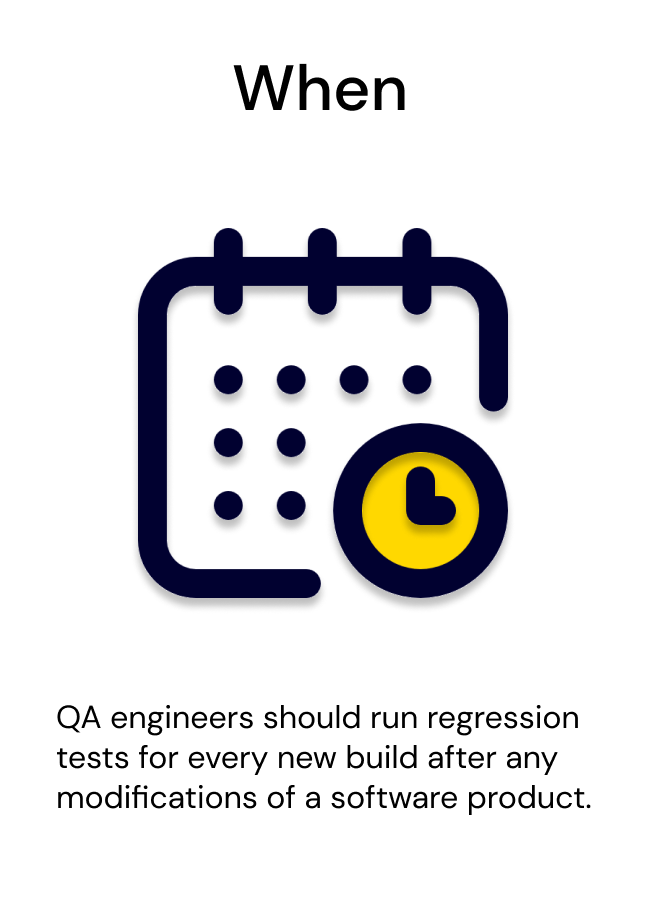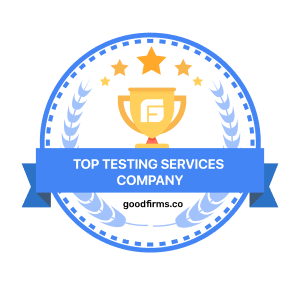Automated Regression Testing Services


Why Do Automated Regression Testing Services With Us?
Benefits From Automated Regression Testing
When You Need Automated Regression Testing Services?
Software can exhibit unpredictability, where even small code modifications can impact unchanged functionality.
Such changes can cause features that were previously functioning properly to stop working.
To mitigate this risk, QA specialists conduct regression testing.
Regression testing involves retesting the unchanged parts of the software to ensure that new modifications haven't introduced unexpected issues.
By running regression tests, QA teams aim to maintain the stability and reliability of the software across different versions and updates.
Regression tests should be conducted by QA engineers for every new build following any modifications made to a software product.

What Our Customers Say
Industries We Work With
Our Expertise

Stages of Automating Regression Testing
Start Cooperation Now!

Why Should You Choose Automated Regression Testing Services?
Ensuring the utmost quality of software products is an indispensable priority. The journey toward delivering flawless software entails traversing through meticulous testing procedures, where the role of software regression testing services emerges prominently.
- Overview of the Importance of Software Testing
Software testing is the bedrock upon which software applications’ reliability, functionality, and user experience are built. It systematically identifies discrepancies between expected and actual outcomes, enhancing software systems’ robustness. Without comprehensive testing, the risks of software glitches, security vulnerabilities, and user dissatisfaction escalate significantly.
- Introduction to Regression Testing
Within the spectrum of software testing methodologies, regression testing assumes a pivotal role, particularly in the context of software maintenance and updates. It revolves around verifying that recent code changes have not adversely affected the software’s existing functionalities. As software undergoes continuous evolution, regression testing becomes indispensable to ensure that enhancements or modifications do not inadvertently introduce defects into previously functioning areas.
- Transition to Automated Regression Testing Services
While regression testing remains indispensable, the traditional manual approach is beset with challenges such as time constraints, resource intensiveness, and limited coverage. Herein lies the catalytic role of automated testing for regression. We are automating regression testing endeavors to mitigate these challenges by harnessing the power of technology to streamline the testing process, thereby optimizing efficiency and efficacy. As we delve deeper into automating regression testing, we uncover a paradigm shift towards a more agile, cost-effective, and reliable testing framework.
Through the lens of automated testing services, this article embarks on a journey to explore the transformative potential of automation in revolutionizing software testing practices. We delve into the intricacies of automated regression testing, dissecting its components, elucidating its benefits, and charting a roadmap for successful implementation. Join us as we unravel the essence of automated testing and unlock the keys to maximizing efficiency in software development.
Understanding Regression Testing Services
This testing encompasses a suite of methodologies and practices for verifying that modifications or enhancements to software applications haven’t inadvertently disrupted previously functioning features. They are a critical pillar in the software development lifecycle, safeguarding against regression defects and ensuring the continual integrity of software systems.
- Defining Testing for Regression
At its core,it testing involves the systematic re-execution of previously conducted test cases to validate the unchanged areas of the software and identify any unintended consequences of recent changes. By revisiting and revalidating existing functionalities, regression testing mitigates the risk of regression defects, which may arise due to code modifications, updates, or integrations.
- Iterative Nature of Regression Testing
Regression testing is inherently iterative, aligning closely with the iterative and incremental methodologies pervasive in modern software development practices. As software evolves through successive iterations or releases, regression testing iteratively verifies that new code changes do not inadvertently introduce defects or regressions into the existing codebase. This iterative approach ensures the stability and reliability of software systems amidst ongoing development cycles.
- Necessity During Software Updates and Modifications
Regression testing assumes heightened significance during software updates, patches, or modifications. Any alterations to the codebase, whether intended enhancements or bug fixes, possess the potential to trigger unforeseen side effects or regressions in previously stable functionalities. By subjecting the software to comprehensive regression testing, development teams can confidently validate the impact of changes and safeguard against unintended consequences, thereby preserving the software’s overall quality and user experience.
- Challenges of Manual Regression Testing
Manual regression testing, while essential, presents inherent challenges that impede efficiency and accuracy. The manual execution of test cases is labor-intensive and time-consuming, often requiring significant human effort to retest functionalities that may have already been validated in previous cycles. Moreover, the susceptibility to human error introduces uncertainty, potentially leading to overlooked defects or inconsistent testing outcomes. In the fast-paced software development landscape, these challenges underscore the necessity of exploring automated services for regression testing as a viable solution to enhance efficiency and mitigate.
The Evolution of Automation in Regression Testing
The journey of automating regression testing represents a transformative evolution in software testing methodologies, propelled by the imperative to enhance efficiency, accuracy, and overall quality assurance practices. From its humble origins rooted in manual testing methods to the advent of sophisticated automated tools and software regression testing services, regression testing automation mirrors the rapid progression of technology and the evolving demands of modern software development.
The transition from Manual Methods to Automated Tools and Services
Historically, regression testing primarily relied on manual execution, wherein testers painstakingly re-ran test cases to ensure the continued functionality of software applications. While effective to a certain extent, manual regression testing proved inherently labor-intensive, time-consuming, and prone to human error. As software systems grew increasingly complex and development cycles accelerated, the limitations of manual testing became increasingly apparent.
The industry witnessed a paradigm shift towards automating regression testing in response to these challenges. This transition marked a pivotal moment, leveraging advancements in software automation technologies to streamline testing processes, enhance test coverage, and expedite time-to-market. Automated regression testing services emerged as a game-changer, offering a scalable, efficient, and reliable alternative to traditional manual approaches.
Advantages of Automating Regression Testing
The advantages of its testing are manifold, underpinning its widespread adoption and integration into contemporary software development workflows. By harnessing the power of automation, organizations stand to reap significant benefits, including:
- Increased Efficiency: Automated regression testing enables the rapid execution of test cases across diverse platforms, configurations, and environments. By automating repetitive tasks, such as test case execution and result verification, development teams can significantly reduce testing time and accelerate the software delivery pipeline.
- Enhanced Accuracy: Automation eliminates the inherent variability and subjectivity associated with manual testing, thereby enhancing the accuracy and consistency of testing outcomes. Automated services for regression testing meticulously record and replay test scenarios, ensuring precise validation of software functionalities and behaviors.
- Improved Test Coverage: Automation facilitates comprehensive test coverage by executing many test cases across different scenarios and edge cases. With automated regression testing services, organizations can achieve broader test coverage, identify hidden defects, and mitigate the risk of regression issues slipping through the cracks.
- Cost Savings: While the initial investment in automated regression testing tools and services may seem substantial, the long-term cost savings are undeniable. By reducing manual effort, minimizing defect discovery costs, and accelerating time-to-market, automation yields significant returns on investment (ROI) over the software development lifecycle.
Popular Automated Regression Testing Tools and Frameworks
Many automated regression testing tools and frameworks have increased the market, catering to diverse development environments, technologies, and testing requirements. Some notable examples include:
Selenium | Selenium, widely regarded as the de facto standard for web application testing, offers a robust, open-source framework for automating browser-based regression tests. Its user-friendly interface and comprehensive documentation empower developers, testers, and project managers to efficiently automate their testing processes. |
Appium | Designed for mobile application testing, Appium enables the automation of native, hybrid, and mobile web applications across iOS, Android, and Windows platforms. |
JUnit | JUnit is primarily used for unit testing in Java-based applications. It provides a framework for writing and executing automated tests, including regression tests, with ease and efficiency. |
Cypress | Known for its simplicity and speed, Cypress is a modern JavaScript-based testing framework that excels in end-to-end testing and regression testing of web applications. |
TestComplete | A comprehensive automated testing platform, TestComplete offers a rich set of features for automating regression tests across desktop, web, and mobile applications. |
A comprehensive automated testing platform, TestComplete offers a rich set of features for automating regression tests across desktop, web, and mobile applications.
These examples merely scratch the surface of the vast landscape of automated regression testing tools and frameworks available to developers and QA professionals. By leveraging these tools judiciously and integrating them into their testing strategies, organizations can unlock the full potential of automation in regression testing, ushering in a new era of efficiency, reliability, and innovation in software development.
Critical Components of Automated Services for Regression Testing
Automated services for regression testing encompass a suite of essential components that work harmoniously to streamline the testing process, enhance efficiency, and ensure the continued integrity of software applications. By leveraging a combination of test automation frameworks, scripting languages, and continuous integration tools, organizations can achieve comprehensive test coverage, expedite test execution, and mitigate the risk of regression defects slipping through the cracks. Software regression testing services play a pivotal role in this ecosystem, offering specialized expertise and tailored solutions to meet the evolving needs of software development projects.
Test Automation Frameworks
Robust test automation frameworks, which serve as the backbone of the testing infrastructure, lie at the heart of automated services for regression testing. These frameworks provide a structured environment for organizing, executing, and managing automated tests across various scenarios and configurations. These frameworks offer a range of functionalities, including test case management, test data handling, and result reporting, facilitating seamless test execution and analysis.
Scripting Languages
Scripting languages are pivotal in automating regression testing, providing the means to express test scenarios, interact with application interfaces, and validate expected outcomes. Commonly used scripting languages in regression testing include Python, Java, JavaScript, and Ruby, each offering unique strengths and capabilities. These languages enable testers to write reusable, maintainable test scripts that simulate user interactions, manipulate data, and verify application behavior, thereby driving efficiency and scalability in the testing process.
Continuous Integration Tools
Continuous integration (CI) tools are integral to automated services for regression testing, facilitating the seamless integration of automated tests into the software development pipeline. CI tools automate the process of building, testing, and deploying software increments, enabling development teams to detect and address regression defects early in the development cycle. Organizations can achieve rapid feedback loops by integrating automated regression tests with CI pipelines, promptly identifying regression issues, and maintaining software systems’ stability across iterative releases.
Contribution to Streamlining the Testing Process
Each component of automated services for regression testing contributes synergistically to streamlining the testing process and improving overall efficiency:
- Test Automation Frameworks: By providing a structured framework for test execution and management, test automation frameworks enable testers to orchestrate complex test scenarios efficiently, reducing manual effort and minimizing the risk of human error.
- Scripting Languages: Scripting languages empower testers to express test scenarios concisely and readable, facilitating rapid test script development and maintenance. Additionally, scripting languages enable testers to customize test scripts to accommodate diverse testing requirements and scenarios, enhancing the adaptability and scalability of automated regression testing.
- Continuous Integration Tools: By seamlessly integrating automated regression tests into CI pipelines, continuous integration tools promote a culture of automated testing and continuous improvement. CI tools automate the execution of regression tests in response to code changes, enabling development teams to detect regression defects early and iterate rapidly toward stable software releases.
In essence, the key components of automated services for regression testing work in tandem to optimize the testing process, accelerate time-to-market, and ensure the delivery of high-quality software products. By embracing these components and harnessing the power of automation, organizations can achieve greater efficiency, reliability, and agility in their software development endeavors.
Benefits of Automated Services for Regression Testing
Automated services for regression testing offer many benefits that significantly impact software development processes’ efficiency, reliability, and cost-effectiveness. By harnessing the power of automation, organizations can streamline testing workflows, enhance test coverage, and accelerate time-to-market, thereby driving tangible value and ensuring the delivery of high-quality software products. Software regression testing services play a crucial role in realizing these benefits by providing specialized expertise, robust testing frameworks, and tailored solutions to address each project’s unique challenges.
Faster Test Execution
One of the primary advantages of automated services for regression testing is the ability to execute tests at unprecedented speeds. Automation eliminates manual intervention in test execution, enabling tests to run concurrently across multiple environments and configurations. As a result, regression tests that once took days or weeks to complete can now be executed within hours or even minutes, enabling development teams to iterate rapidly and respond promptly to code changes and updates.
Reduced Manual Effort
Automation alleviates the burden of manual testing, freeing up valuable time and resources that can be redirected toward more strategic tasks. By automating repetitive and time-consuming test activities, such as test case execution, data setup, and result verification, testers can focus on higher-value activities, such as test design, analysis, and defect resolution. This reduction in manual effort enhances productivity and minimizes the risk of human error, thereby improving the overall reliability and accuracy of testing outcomes.
Improved Test Coverage
Automation facilitates comprehensive test coverage by executing vast test scenarios across diverse platforms, configurations, and environments. Automated services for regression testing can simulate complex user interactions, edge cases, and boundary conditions that are impractical or impossible to test manually. By expanding test coverage, organizations can identify and address regression defects early in the development cycle, thereby reducing the risk of costly rework and ensuring the continued integrity of software applications.
Better Resource Allocation and Cost Savings
Automation optimizes testing processes and minimizes manual overhead, leading to better resource allocation and long-term cost savings. By automating regression testing services, organizations can allocate their human resources more strategically, focusing on tasks that require creativity, critical thinking, and domain expertise. Additionally, automation reduces the need for dedicated testing infrastructure and resources, such as physical hardware, testing environments, and manual testers, lowering operational expenses and enhancing overall cost-effectiveness.
Case Studies and Testimonials
Numerous case studies and testimonials attest to the tangible benefits of implementing automated services for regression testing across various industries and domains. For example, a leading software company reported a 50% reduction in regression testing time and a 30% increase in test coverage after adopting automated services for regression testing. Similarly, a healthcare organization witnessed a significant improvement in software quality and reliability, resulting in fewer defects and higher customer satisfaction rates.
These real-world examples underscore the transformative impact of automation on software testing practices and highlight the substantial value that automated services for regression testing bring to organizations striving for excellence in software development. By embracing automation, organizations can unlock new levels of efficiency, agility, and innovation, paving the way for continued success in today’s competitive market landscape.
Implementation Strategies for Automating Regression Testing
Integrating automated regression testing into existing software development workflows requires careful planning, strategic execution, and a keen understanding of project requirements. By following proven implementation strategies and best practices, organizations can maximize the effectiveness of automated services for regression testing and realize the full potential of automation in software testing.
Integrating Automated Regression Testing into Development Workflows
The seamless integration of automated regression testing into software development workflows is paramount to its success. To achieve this, organizations should consider the following implementation strategies:
- Early Involvement: Involve testing teams early in the development process to identify regression testing needs and requirements. Organizations can proactively address regression defects and minimize rework by integrating testing activities into the iterative development cycle.
- Continuous Integration and Deployment (CI/CD): Leverage CI/CD pipelines to automate the execution of regression tests as part of the software build and deployment process. By integrating automated regression testing into CI/CD workflows, organizations can ensure that tests are executed consistently and reliably across different development stages.
- Tool Integration: Integrate automated regression testing tools with existing development and testing tools, such as version control systems, issue tracking systems, and test management platforms. Seamless tool integration enhances collaboration, visibility, and traceability throughout the software development lifecycle.
- Scalability and Flexibility: Design regression testing frameworks and automation scripts with scalability and flexibility in mind. Ensure that automated tests can accommodate changes in software requirements, configurations, and environments without requiring extensive rework or maintenance.
Selecting Suitable Automation Tools and Frameworks
Selecting the right automation tools and frameworks is critical to the success of automated regression testing initiatives. Consider the following best practices when selecting automation tools and frameworks:
- Assess Project Requirements: Conduct a thorough assessment of project requirements, including technology stack, application architecture, testing objectives, and budget constraints. Choose automation tools and frameworks that align with project requirements and objectives.
- Evaluate Tool Capabilities: Evaluate the capabilities and features of automation tools and frameworks, such as support for multiple platforms, scripting languages, and integration with other tools. Choose tools that offer a comprehensive suite of features and functionalities to meet project needs.
Consider Community Support and Documentation: Consider the level of community support, documentation, and resources available for automation tools and frameworks. Choose tools with active communities, extensive documentation, and a wealth of resources to support users. - Pilot Testing: Conduct pilot testing or proof-of-concept exercises to evaluate the feasibility and effectiveness of automation tools and frameworks in the context of project requirements. Use pilot testing to identify any limitations, challenges, or compatibility issues early in the evaluation process.
Addressing Common Challenges and Offering Solutions
Despite the benefits of automated regression testing, organizations may encounter common challenges during the implementation process. Some common challenges include:
- Technical Challenges: Address technical challenges, such as compatibility issues, tool integration complexities, and scalability limitations, by collaborating with technical experts, leveraging vendor support, and conducting thorough testing and validation.
- Skills and Training: Invest in training and upskilling testing teams to use automation tools and frameworks effectively. Provide comprehensive training programs, workshops, and resources to ensure testing teams have the skills and expertise to succeed.
- Resistance to Change: Address resistance to change by fostering a culture of collaboration, transparency, and continuous improvement. Communicate the benefits of automated regression testing to stakeholders, involve them in decision-making, and proactively address their concerns.
- Maintenance and Support: Develop robust maintenance and support processes to address ongoing maintenance needs, updates, and enhancements to automation scripts and frameworks. Establish clear roles, responsibilities, and escalation procedures for handling maintenance and support requests.
By implementing these strategies and best practices, organizations can overcome common challenges, maximize the effectiveness of automated services for regression testing, and realize the full potential of automation in software testing.
Measuring Success and ROI of Automated Regression Testing Services
Evaluating the success of automated regression testing initiatives requires a comprehensive understanding of key metrics and performance indicators that reflect the efficacy and impact of automation on software quality assurance processes. By measuring metrics such as test coverage, defect detection rates, and time savings, organizations can assess the effectiveness of automated services for regression testing and justify the adoption of automation through tangible return on investment (ROI).
Metrics for Evaluating Success
- Test Coverage: Test coverage measures the extent to which automated regression tests exercise the functionalities and components of the software under test. A higher test coverage indicates a greater assurance of software quality and reliability as more application areas are subjected to testing. Organizations can measure test coverage by analyzing the percentage of code paths, requirements, or use cases covered by automated regression tests.
- Defect Detection Rates: Defect detection rates quantify the effectiveness of automated regression testing in identifying and reporting software defects. By tracking the number of defects detected by automated regression tests over time, organizations can assess the reliability and thoroughness of their testing efforts. High defect detection rates indicate robust test coverage and early detection of regression issues, enabling timely resolution and mitigation.
- Time Savings: Time savings measure the reduction in testing effort and duration achieved through automation. Organizations can quantify the efficiency gains and productivity improvements automation enables by comparing the time required to execute automated regression tests against manual testing efforts. Time savings metrics provide insights into the accelerated testing cycles, faster time-to-market, and increased agility facilitated by automated services for regression testing
Importance of Measuring ROI
Measuring return on investment (ROI) is crucial for justifying the adoption of automated services for regression testing and demonstrating the value generated by automation initiatives. ROI analysis considers the costs associated with implementing and maintaining automated regression testing against the benefits of improved software quality, reduced defect rates, and increased productivity. Critical aspects of measuring ROI include:
- Cost Reduction: Calculate the cost savings achieved through automation, including reductions in manual testing effort, labor costs, and infrastructure expenses. By quantifying the cost savings enabled by automated services for regression testing, organizations can justify investments in automation and allocate resources more effectively.
- Quality Improvement: Assess defect density, customer satisfaction ratings, and post-release defects to measure automation’s impact on software quality and reliability. Improved software quality resulting from automated regression testing contributes to reduced rework, lower maintenance expenses, and enhanced customer trust and loyalty.
- Time-to-Market Acceleration: Evaluate the impact of automation on time-to-market by comparing the time required to release software increments before and after implementing automated services for regression testing. Accelerated testing cycles enable faster delivery of features, enhancements, and updates, facilitating competitive advantage and market differentiation.
Case Studies and Examples
- Company X: Company X implemented automated services for regression testing and achieved a 50% reduction in manual testing effort, resulting in annual cost savings of $500,000. Additionally, adopting automation led to a 30% improvement in defect detection rates, contributing to enhanced software quality and customer satisfaction.
- Company Y: After implementing automated services for regression testing, Company Y measured a 40% increase in test coverage, leading to a 25% reduction in post-release defects. By quantifying the impact of automation on test coverage and defect rates, Company Y justified the ROI of automation and continued to invest in automation initiatives to improve software quality further.
These case studies demonstrate the importance of measuring success metrics and ROI to validate the effectiveness and value of automated services for regression testing. By aligning automation initiatives with strategic business objectives and quantifying the benefits generated by automation, organizations can make informed decisions, prioritize investments, and drive continuous improvement in software quality assurance processes.
Future Trends and Innovations in Automated Regression Testing Services
As technology advances rapidly, the landscape of automated services for regression testing is poised to undergo significant transformation. Emerging trends and innovations, including AI-driven testing and predictive analytics, are reshaping how organizations approach regression testing, offering new possibilities for improving efficiency, accuracy, and reliability in software testing processes.
AI-Driven Testing
AI-driven testing represents a paradigm shift in automated services for regression testing, leveraging machine learning algorithms and artificial intelligence techniques to enhance test generation, execution, and analysis. AI-powered testing tools can autonomously learn from past test results, identify patterns, and optimize test coverage to prioritize high-risk areas of the application. By harnessing AI’s predictive capabilities, organizations can achieve more efficient and effective regression testing, uncovering defects before they impact end-users and improving overall software quality.
Predictive Analytics
Predictive analytics holds immense potential for revolutionizing automated regression testing by enabling organizations to anticipate and prevent regression defects before they occur. By analyzing historical test data, code changes, and environmental factors, predictive analytics models can forecast the likelihood of regression issues and recommend preventive actions to mitigate risks. Predictive analytics empowers organizations to proactively manage regression testing efforts, optimize resource allocation, and prioritize testing activities based on predicted defect probability and impact.
Potential Impact of Evolving Technologies
The evolution of AI-driven testing and predictive analytics is expected to have a profound impact on the future of services for regression testing, offering new capabilities and possibilities for improving testing efficiency and effectiveness:
- Enhanced Test Automation: AI-driven testing tools will enable organizations to automate the generation of test cases, the execution of tests, and the analysis of test results with minimal human intervention. By leveraging AI for test automation, organizations can achieve higher test coverage, faster test execution, and more accurate defect detection, accelerating the software development lifecycle and reducing time-to-market.
- Improved Test Prioritization: Predictive analytics models will empower organizations to prioritize regression testing efforts based on the predicted impact and likelihood of regression defects. By focusing testing resources on high-risk areas of the application, organizations can maximize test coverage while minimizing testing effort, ensuring that critical defects are identified and addressed before they impact end-users.
- Real-Time Test Monitoring: AI-driven testing and predictive analytics will enable real-time monitoring of test execution and analysis, allowing organizations to identify regression issues as they occur and take immediate corrective actions. By leveraging real-time insights, organizations can streamline test management, optimize resource allocation, and proactively address emerging testing challenges, ensuring software applications’ continuous integrity and reliability.
In conclusion, the future of automated services for regression testing is bright, with emerging technologies such as AI-driven testing and predictive analytics poised to revolutionize how organizations approach regression testing. By embracing these trends and innovations, organizations can unlock new possibilities for improving testing efficiency, accuracy, and reliability, ultimately driving more excellent value and success in software development initiatives.
Final thoughts
In conclusion, automated services for regression testing are pivotal in maximizing efficiency and ensuring the delivery of high-quality software products. Throughout this discussion, we have explored the significance of automating regression testing and its impact on software development processes.
Automated services for regression testing streamline the testing process, accelerate test execution, and enhance test coverage, enabling organizations to detect and address regression defects more effectively. Organizations can achieve greater efficiency, accuracy, and reliability in regression testing efforts by automating repetitive testing tasks and leveraging advanced technologies such as AI-driven testing and predictive analytics. Software regression testing services are indispensable in this pursuit, providing tailored solutions and expertise to navigate the complexities of regression testing.
Software development teams must embrace automation as a cornerstone of their testing strategy. Automation improves software quality and accelerates time-to-market, enabling organizations to meet the evolving needs of customers and stakeholders more rapidly. By adopting automated regression testing practices, organizations can drive innovation, reduce testing cycles, and deliver value to end-users with incredible speed and agility.
As we look towards the future of software development, the call to action is clear: Embrace automation, leverage automated services for regression testing, and embark on a journey towards continuous improvement and excellence in software quality assurance. By embracing automation-driven practices, software development teams can navigate the complexities of modern software development with confidence, efficiency, and resilience. Let us seize the opportunity to embrace automation and propel our organizations toward tremendous success and innovation in the ever-evolving software development landscape.
Frequently Asked Questions:
What is regression testing?
Regression testing in software engineering is a type of QA testing used to verify if new changes in the codebase didn’t affect the existing functionality of the application.
How does regression testing help in producing quality software?
With every new alteration, bug fix, a system update, or a new feature implementation, the probability of software issues increases. Unless you do regression testing, you can miss the bugs on production. Regression automation testing helps you maintain the quality of every release. It is the “stepchild” of regression testing, critical to enable agile teams to deliver quality software over and over again
When to perform regression testing?
Below are a few most common scenarios for regression testing:
– Carrying out test cases with frequent defects
– Testing user-facing functionality
– Verifying core product features
– Testing integration test cases
Should regression testing be automated?
Regression testing is perfect for test automation since it is so repetitive. Automation of regression testing is, in fact, a must for anything other than a modest project.
Why regression testing is required?
The functionality of new programming code is evaluated.
Ensures that new coding does not conflict with current coding.
After installing software updates, ensures that there are no faults or issues.
Allows existing software to be retested after changes to the application.
What is the difference between regression testing, integration testing, and unit testing?
Let’s explain the difference between the three using an example. Imagine you’re building an ecommerce website. You need to do Unit testing to test a large chunk of code or module responsible for inventory management. Integration testing comes into play when you need to add a third-party payment system to your ecommerce website. This testing helps you make sure that integrating two systems doesn’t break anything and the flow is working as intended. At last, you are making regression testing to see if your newly added features such as an inventory management module and a payment system didn’t break anything else on your website. Regression testing is about re-testing the functionality every time you implement changes.
Unit testing is done by software developers. Integration testing is done by both developers and testers. And regression testing is performed by testers.
Regression testing: manual or automation?
We always recommend automating frequently repeated test cases, especially at large projects. If you have a small application with rapidly-evolving features, manual testing may be your most efficient approach.
What are the areas for automation of regression testing?
There are three aspects to consider when adopting a regression test automation approach: process, technology, and responsibilities.
What tools are used for regression testing?
– Subject7
– Cerberus Testing
– Testimony
– Digivante
– Testsigma
– TimeShiftX
– Appsurify TestBrain
– Avo Assure
– testRigor
– Sahi Pro








